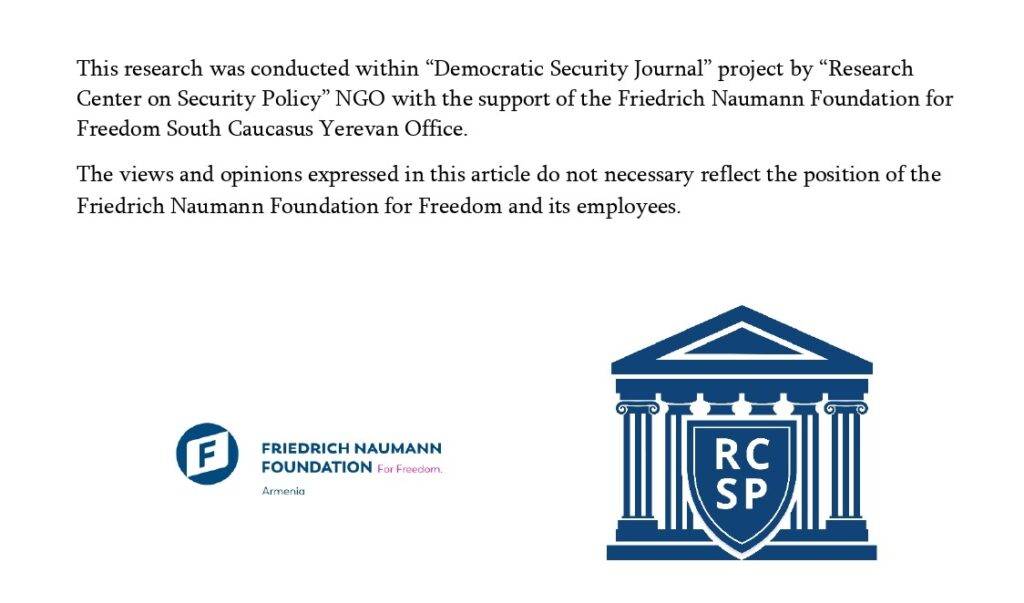Preface
Azerbaijan has not demonstrated the political will to sign a peace agreement with Armenia. Simultaneously, official Baku continues to generate narratives which, although veiled in the rhetoric of “human rights,” in reality contain overt territorial claims toward Armenia. This article presents the development, transformation, and institutionalization of those Azerbaijani narratives.
Sabotage of the Peace Agreement Signing
On March 13, it was announced that Armenia and Azerbaijan had agreed on the draft text of a peace and interstate relations agreement[i]. The announcement received wide international attention: around 60 countries and ten international organizations have already welcomed the conclusion of negotiations between Armenia and Azerbaijan. Many have emphasized the urgency of signing the agreement. Official Yerevan has declared its readiness to begin consultations with Azerbaijan on determining the date and location for the signing of the agreement[ii].
Azerbaijan, however, while claiming that the positions of the Armenian and Azerbaijani sides have significantly converged, has not demonstrated sufficient political will to proceed with signing the agreement. Persisting in its non-constructive stance, President Aliyev has put forward two preconditions, stating that only upon their fulfillment can a peace agreement be concluded. These preconditions are: the dissolution of the OSCE Minsk Group Co-Chairmanship, and the amendment of Armenia’s Constitution, which, according to Baku, contains territorial claims against Azerbaijan.
With regard to the dissolution of the Minsk Group Co-Chairmanship, the Armenian side, generally speaking, does not object, guided by the logic of conflict resolution. Official Yerevan proposes to sign the peace agreement and simultaneously submit a joint request to the OSCE for the dissolution of the Minsk Group structures—on the same day, at the same location[iii].
As for the concerns raised by Azerbaijan regarding Armenia’s Constitution, these are legally unsubstantiated. The Constitutional Court of Armenia, which is the sole authority empowered to interpret the country’s Constitution, issued an irrevocable ruling on September 26, 2024, declaring that the Constitution contains no territorial claims directed at Azerbaijan or any other country. This decision carries the highest legal authority and is not subject to reversal[iv].
Against this backdrop, Azerbaijan categorically denies Armenia’s assertions about its territorial claims, despite the existence of both legal and practical political manifestations of such claims.
Constitutional Claims
The Armenian side has repeatedly raised concerns regarding the presence of territorial claims against the Republic of Armenia in the Constitution of the Republic of Azerbaijan. The preamble of Azerbaijan’s Constitution, adopted in 1995, states that the principles of the Constitutional Act “On the Independence of the Republic of Azerbaijan” are considered foundational[v]. According to Article 2 of that law, adopted in 1991, the Republic of Azerbaijan is the legal successor of the Azerbaijan Democratic Republic that existed from 1918 to 1920. The preamble of the same Constitutional Act states that the adoption of the law is based on the principles of the Declaration of Independence adopted on May 28, 1918, by the National Council of Azerbaijan[vi].
Article 1 of Azerbaijan’s first Declaration of Independence defines the Republic of Azerbaijan as consisting of the “eastern and southern parts of Transcaucasia.”
According to the administrative-territorial division presented to the Entente powers in November 1919, Azerbaijan laid claim to significant portions of Armenian territory, including areas that are now part of modern Armenia—specifically the regions of Syunik and Vayots Dzor, as well as portions of the Ararat, Armavir, Gegharkunik, Tavush, Lori, and Shirak regions[vii].
In the package submitted to the Paris Peace Conference in 1919, along with a map, Azerbaijan made no claims only to certain parts of the present-day territories of Yerevan, Lori, Shirak, Aragatsotn, Gegharkunik, and Kotayk.
In November 1920, at the League of Nations, the Azerbaijan Democratic Republic claimed a territory of 108,000 square kilometers, noting that the figure would increase to 141,000 square kilometers should border disputes with Armenia and Georgia be resolved. By December of that year, the Fifth Committee of the League of Nations had rejected Azerbaijan’s application, explaining that it was difficult to determine the total territory of Azerbaijan and that ongoing border disputes with neighboring countries made it impossible to ascertain the country’s current borders[viii].
According to the Armenian side, the resolution of concerns related to Azerbaijan’s Constitution lies in the signing of a peace treaty, which would officially confirm that the parties have no territorial claims against one another and undertake not to raise such claims in the future. Moreover, under the treaty, the parties would be prohibited from invoking domestic legislation to justify non-compliance with its provisions.
The Transformation of the “Western Azerbaijan” Narrative
In addition to the indirect claims embedded in its Constitution, the Azerbaijani side continues to promote the so-called “Western Azerbaijan” narrative in both the public and political domains. This narrative also implies territorial claims against the sovereign territory of Armenia.
Assertions regarding territorial demands from Armenia are by no means new. The transformation of these claims can conditionally be divided into three phases:
• Phase 1: Inception (1991–1998)
As early as the 1990s, Heydar Aliyev, both in his capacity as a Member of Parliament and later as President, made repeated statements portraying Armenia’s Syunik and Gegharkunik regions as “historical Azerbaijani lands.” He asserted that these territories came under Armenian control solely due to Soviet authorities’ actions.[ix] [x] [xi]
These statements were primarily intended for a domestic audience, aimed at reinforcing national unity and legitimizing military and diplomatic actions.
• Phase 2: Development and Dissemination (1998–2020)
In 1998, Heydar Aliyev introduced the term “Western Azerbaijan” into public discourse[xii], despite the fact that no such entity has ever existed in history. The territorial claims against Armenia continued and became more assertive during the presidency of his son, Ilham Aliyev, who assumed office in 2003[xiii] [xiv] [xv].
During this period, the concept of “historical Azerbaijani lands” was expanded to include the historical “Yerevan Khanate” as well[xvi] [xvii].
Statements from Azerbaijan’s highest leadership began to circulate claims of “genocide” and “forcible expulsion” of Azerbaijanis from Armenia. At the same time, Azerbaijani rhetoric shifted from emotional and historical contexts to other dimensions. There were calls to document history, educate the younger generation, and build a state ideology rooted in these narratives.
With government funding, so-called legitimizing materials for the claims were produced—such as historical works, maps, research publications, and films.
The narrative of territorial claims toward Armenia gradually became an element of official state propaganda, now aimed not only at a domestic audience but also at international platforms. Ilham Aliyev began internationalizing these claims by voicing them in the Parliamentary Assembly of the Council of Europe (PACE)[xviii], the Organization of Turkic States[xix], UNESCO, and other international forums[xx].
Starting in 2014, Azerbaijani statements began to emphasize the “necessity of return” of Azerbaijanis to Western Azerbaijan[xxi]. Ilham Aliyev declared it a strategic objective, emphasizing that the country’s economic, political, military potential and demographic situation make such a return possible[xxii].
• Phase 3: Institutionalization (2020–Present)
Statements containing territorial claims against Armenia intensified following the 44-day war of 2020, which created a new status quo in the region.
In July 2021, Ilham Aliyev signed a decree on a new administrative-territorial division of economic regions in Azerbaijan, which introduced a new unit called “Eastern Zangezur”[xxiii].
Days later, Ilham Aliyev declared: “If there is Eastern Zangezur, then there must also be Western Zangezur, to which we must inevitably return.”[xxiv]
In August 2021, the President of Azerbaijan announced that “all old Azerbaijani settlements” within Armenian territory should be referred to by their Azerbaijani names, urging journalists and the public to use only those names[xxv].
In July 2022, the Azerbaijani government amended the resolution “On the approval of certain normative legal acts related to the application of the Family Code of the Republic of Azerbaijan.”[xxvi] Under the new regulations, place names located in the territory of Armenia must be written using “Azerbaijani versions” in official documents. In other words, Armenian names are bypassed, and names of non-existent Azerbaijani settlements are listed instead in the documents of Azerbaijani citizens.
The Ministry of Defense of Azerbaijan follows the same approach, referring to various regions and settlements in Armenia by their Azerbaijani names in all its reports on border incidents.
Notably, many of these toponyms circulated by the Azerbaijani side trace back to periods of the Ottoman Empire, the Safavid Persian Empire, or medieval Turkic formations—and have no direct connection with modern Azerbaijan.
In December 2022, the Presidium of the Azerbaijan National Academy of Sciences approved the opening of three departments dedicated to “Western Azerbaijan.”[xxvii]
At the Institute of History: Department of the History of Western Azerbaijan
At the Institute of Folklore: Department of Folklore of Western Azerbaijan
At the Institute of Linguistics: Department of Toponymy of Western Azerbaijan
The Azerbaijani authorities also took steps to institutionalize the “Western Azerbaijan” narrative. The “Union of Azerbaijani Refugees,” a public organization established in 1989 to deal with the issues of Azerbaijani refugees, was restructured in 2022, gaining a new name: “Community of Western Azerbaijan.”
This body was tasked with developing, promoting, and internationalizing the narratives of “forcible deportation of Azerbaijanis from Armenia” and “their right of return.” A new building was allocated to the community in Baku, and in December 2022, President Aliyev personally visited the site, instructing the development of a “Return Concept,” which was published one month later.
Interestingly, on the official website of the organization, the territory of “Western Azerbaijan” is identical to that of the present-day Republic of Armenia.[xxviii] According to the Return Concept, not only the “refugees” themselves (whose number is sometimes stated to be 300,000) are to return to Armenia, but also their descendants.
To enable this process, the organization calls for “international monitoring, accountability, security measures, intervention, and other necessary actions to prevent the expulsion, discrimination, or harm to the returning population.”
The Community of Western Azerbaijan maintains close ties with the Presidential Administration and Ministry of Foreign Affairs of Azerbaijan and is effectively coordinated by Azerbaijani authorities. The organization clearly receives financial, diplomatic, and informational support. Since 2023, a dedicated television channel, “Western Azerbaijan TV,” has also been operating.
Responsibility for developing the narrative’s “archival” component has been assigned to the Heydar Aliyev Foundation, headed by First Lady and First Vice President Mehriban Aliyeva. The Foundation has financed the creation of platforms such as “Virtual Western Azerbaijan.”[xxix]
In December 2024, Azerbaijan’s National Assembly (Milli Majlis) formed an Initiative Group for Return to Western Azerbaijan, one of whose main tasks is to raise the issue in forums of parliamentary diplomacy. Notably, the Community of Western Azerbaijan is led by Milli Majlis MP Aziz Alekberli, and his three deputies are also members of parliament.[xxx] In official capacities, they participate in various international conferences and events—but do so as representatives of the Community of Western Azerbaijan.
Summary
The intensification and institutionalization of the “Western Azerbaijan” and “return of Azerbaijanis” narratives by official Baku have become a tool for exerting pressure and influence on the Armenian government and society—one that the Azerbaijani side is unlikely to abandon in the foreseeable future. At the same time, there is a clear trend of this narrative penetrating and taking root within Azerbaijan’s state system. Strategically, Azerbaijan pursues two main goals through the promotion of these narratives:
- Minimum Objective
By amplifying the narratives of “Western Azerbaijan,” “genocide and forced displacement,” and “return of Azerbaijanis,” Azerbaijani authorities aim to mirror and counter the demand for the return of Armenians to Nagorno-Karabakh. The objective is to frame and interlink the two issues on the same level, portraying them as parallel and interconnected. - Maximum Objective
Azerbaijan’s long-term strategy related to these narratives should be viewed through the lens of an irredentist policy. It cannot be ruled out that by undermining the peace process with Armenia, maintaining a “no peace, no war” status quo, and continuing policies of isolation and blockade toward Armenia, Azerbaijan is seeking to buy time—waiting for a favorable international situation in which it can extract further concessions from Armenia, including those tied to the “return” concept. This could become a ticking time bomb for Armenia’s statehood.
Narek Minasyan
[i] https://www.mfa.am/hy/interviews-articles-and-comments/2025/03/13/mfa_statement/13114
[ii] https://shorturl.at/PbzvP
[iii] https://www.azatutyun.am/a/33386149.html
[iv] https://www.concourt.am/decision/decisions/66f6b9067b29c_sdv-1749.pdf
[v] https://e-qanun.az/framework/897
[vi] https://e-qanun.az/framework/6693,%20https:/files.preslib.az/projects/remz/pdf_ru/atr_kons.pdf
[vii] https://e-qanun.az/framework/6693,%20https:/files.preslib.az/projects/remz/pdf_ru/atr_kons.pdf
[ix] https://files.preslib.az/projects/heydaraliyev/cixislar.pdf
[x] https://files.preslib.az/projects/heydaraliyev/cixislar.pdf
[xi] https://files.preslib.az/projects/heydaraliyev/cixislar.pdf
[xii] https://lib.aliyev-heritage.org/az/7012267.html
[xiii] https://ilhamaliyev.preslib.az/docs/i09.pdf
[xiv] https://lib.aliyev-heritage.org/print.php?lang=az&page=6966585
[xv] https://president.az/az/articles/view/2041
[xvi] https://president.az/az/articles/view/9397
[xvii] https://president.az/az/articles/view/12392
[xviii] https://president.az/az/articles/view/12149
[xix] https://president.az/az/articles/view/16110
[xx] https://president.az/az/articles/view/16799
[xxi] https://president.az/az/articles/view/12487
[xxii] https://president.az/az/articles/view/14805
[xxiii] https://president.az/ru/articles/view/52389
[xxiv] https://haqqin.az/news/215119
[xxv] https://president.az/az/articles/view/52742
[xxvi] https://www.kaspiy.az/v-vydannyh-v-armenii-dokumentah-vosstanovyat-s
[xxvii] https://azertag.az/ru/xeber/v_akademii_nauk_sozdany_novye_otdely_svyazannye_s_zapadnym_azerbaidzhanom-2430677
[xxviii] https://westaz.org/az/qerbi-azerbaycan/erazi
[xxix] https://demokrat.az/az/news/189427/virtual-qerbi-azerbaycan-platformasi-teqdim-edildi-foto
[xxx] https://demokrat.az/az/news/189427/virtual-qerbi-azerbaycan-platformasi-teqdim-edildi-foto


